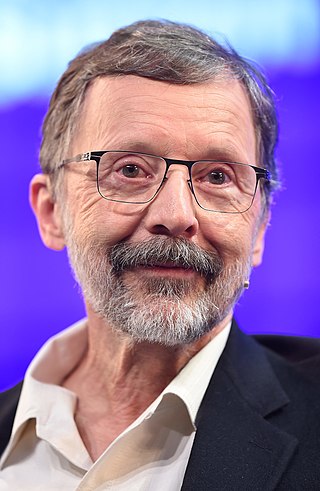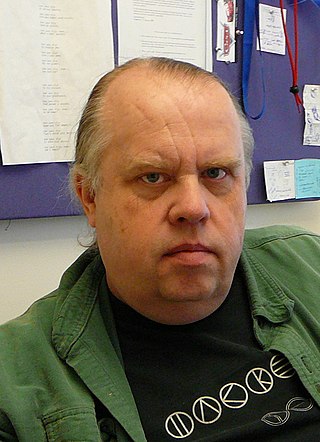Related Research Articles

Rendering or image synthesis is the process of generating a photorealistic or non-photorealistic image from a 2D or 3D model by means of a computer program. The resulting image is referred to as the render. Multiple models can be defined in a scene file containing objects in a strictly defined language or data structure. The scene file contains geometry, viewpoint, texture, lighting, and shading information describing the virtual scene. The data contained in the scene file is then passed to a rendering program to be processed and output to a digital image or raster graphics image file. The term "rendering" is analogous to the concept of an artist's impression of a scene. The term "rendering" is also used to describe the process of calculating effects in a video editing program to produce the final video output.
Metropolis light transport (MLT) is a global illumination application of a variant of the Monte Carlo method called the Metropolis–Hastings algorithm to the rendering equation for generating images from detailed physical descriptions of three-dimensional scenes.

Edwin Earl Catmull is an American computer scientist who is the co-founder of Pixar and was the President of Walt Disney Animation Studios. He has been honored for his contributions to 3D computer graphics, including the 2019 ACM Turing Award.

Thomas Douglas Selkirk Duff is a computer programmer.

Luxo Jr. is a 1986 American computer-animated short film produced and released by Pixar. Written and directed by John Lasseter, the two-minute short film revolves around one larger and one smaller desk lamp. The larger lamp, named Luxo Sr., looks on while the smaller, "younger" Luxo Jr. plays exuberantly with a ball to the extent that it accidentally deflates. Luxo Jr. was Pixar's first animation after Ed Catmull and John Lasseter left Industrial Light & Magic's computer division of Cinetron Computer Systems. The film is the source of Luxo Jr., the mascot of Pixar.

Lance J. Williams was a prominent graphics researcher who made major contributions to texture map prefiltering, shadow rendering algorithms, facial animation, and antialiasing techniques. Williams was one of the first people to recognize the potential of computer graphics to transform film and video making.
Pixar RenderMan is proprietary photorealistic 3D rendering software produced by Pixar Animation Studios. Pixar uses RenderMan to render their in-house 3D animated movie productions and it is also available as a commercial product licensed to third parties. In 2015, a free non-commercial version of RenderMan became available.

Robert L. Cook is a computer graphics researcher and developer, and the co-creator of the RenderMan rendering software. His contributions are considered to be highly influential in the field of animated arts.

Loren C. Carpenter is a computer graphics researcher and developer.

Path tracing is a computer graphics Monte Carlo method of rendering images of three-dimensional scenes such that the global illumination is faithful to reality. Fundamentally, the algorithm is integrating over all the illuminance arriving to a single point on the surface of an object. This illuminance is then reduced by a surface reflectance function (BRDF) to determine how much of it will go towards the viewpoint camera. This integration procedure is repeated for every pixel in the output image. When combined with physically accurate models of surfaces, accurate models of real light sources, and optically correct cameras, path tracing can produce still images that are indistinguishable from photographs.

Alvy Ray Smith III is an American computer scientist who co-founded Lucasfilm's Computer Division and Pixar, participating in the 1980s and 1990s expansion of computer animation into feature film.

Patrick M. Hanrahan is an American computer graphics researcher, the Canon USA Professor of Computer Science and Electrical Engineering in the Computer Graphics Laboratory at Stanford University. His research focuses on rendering algorithms, graphics processing units, as well as scientific illustration and visualization. He has received numerous awards, including the 2019 Turing Award.

William "Bill" Reeves is a Canadian animator and technical director known for working with John Lasseter on the animated shorts Luxo Jr. and The Adventures of André and Wally B.

James F. O'Brien is a computer graphics researcher and professor of computer science and electrical engineering at the University of California, Berkeley. He is also co-founder and chief science officer at Avametric, a company developing software for virtual clothing try on. In 2015, he received an award for Scientific and Technical Achievement from the Academy of Motion Pictures Arts and Sciences.
Maneesh Agrawala is a professor of computer science at Stanford University. He returned to Stanford in 2015 as the director of the Brown Institute for Media Innovation, after nearly a decade on the faculty at the University of California, Berkeley.
Arnold is a computer program for rendering three-dimensional, computer-generated scenes using unbiased, physically-based, Monte Carlo path tracing techniques. Created in Spain by Marcos Fajardo and later co-developed by his company Solid Angle SL and Sony Pictures Imageworks, Arnold is one of the most widely used photorealistic rendering systems in computer graphics worldwide, particularly in animation and VFX for film and TV. Notable feature films that have used Arnold include Monster House, Cloudy with a Chance of Meatballs, Alice in Wonderland, Thor, Captain America, X-Men: First Class, The Avengers, Space Pirate Captain Harlock, Elysium, Pacific Rim, Gravity, Guardians of the Galaxy, Star Wars: The Force Awakens, Arrival and Blade Runner 2049. Notable television series include Game of Thrones, Westworld, Trollhunters, LOVE DEATH + ROBOTS, Jelly Jamm and The Mandalorian.
Matt Pharr is an American computer graphics researcher and writer, and one of the primary originators of the physically based rendering process. His research focuses on rendering algorithms, graphics processing units, as well as scientific illustration and visualization.
Matei Zaharia is a Romanian-Canadian computer scientist, educator and the creator of Apache Spark.
Thomas K. Porter is the senior vice president of production strategy at Pixar and one of the studio's founding employees.

Michael Kass is an American computer scientist best known for his work in computer graphics and computer vision. He has won an Academy Award and the SIGGRAPH Computer Graphics Achievement Award and is an ACM Fellow.
References
- 1 2 3 4 Cassandra Szlarski (2014-02-21). "Canuck computer whiz nabs 2 Academy Awards for movie innovation". CTV News. Archived from the original on 2014-02-26.
- 1 2 3 4 "Eric Veach: Distinguished Software Engineer, Google Inc., 2008 recipient of the J.W. Graham Medal". University of Waterloo. Archived from the original on 2015-09-27. Retrieved 2017-04-25.
Prior to Google, Eric developed computer graphics software for Pixar Animation Studios (with credits in three movies).
- 1 2 Eric Veach (December 1997). "Robust Monte Carlo Methods for Light Transport Simulation". Stanford University . Retrieved 2017-04-25.
- ↑ Lokovic, Tom; Veach, Eric (July 2000). "Deep Shadow Maps". SIGGRAPH '00: Proceedings of the 27th annual conference on Computer graphics and interactive techniques (Abstract).
- ↑ "The Secret To Google's Success". Bloomberg. 2006-03-06. Retrieved 2023-10-31.
- ↑ "Overview | S2Geometry" . Retrieved 2023-10-29.
- 1 2 Academy of Motion Picture Arts and Sciences (2014-02-15). "The 86th Scientific & Technical Awards". Oscars.org.
- ↑ "Dr. Eric Veach". Rainforest Trust . Retrieved 2017-04-25.
As an early employee at Google, he led the development of the AdWords advertising platform and various components of Google Maps including the directions system.
- ↑ Farhad Manjoo (2017-02-08). "Why Silicon Valley Wouldn't Work Without Immigrants". The New York Times . San Francisco. p. B1. Retrieved 2017-04-25.
If you want to understand why tech employees went to the mat against Mr. Trump's executive order barring immigrants from seven Muslim-majority countries, you need to first understand the crucial role that America's relatively open immigration policies play in the tech business.